May-June 2000
A Strange Welcome
Fr. Alvin Parantar, msp
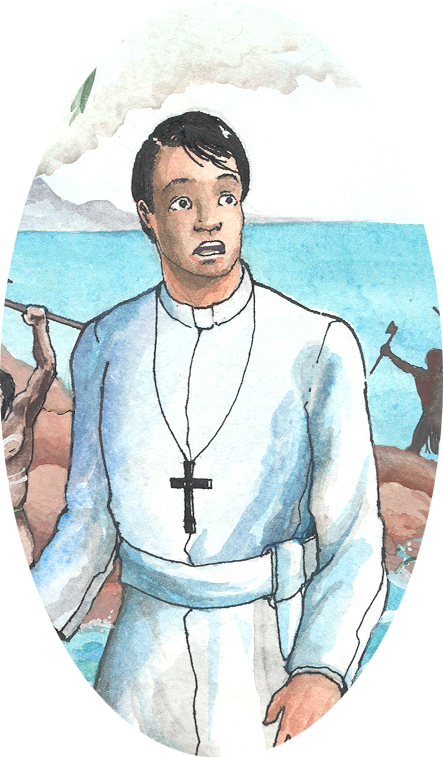
I arrived in the Solomon Islands on February 25, 1998 and since then I have been working in Tangarare Parish in Guadalcanal. My first program was to visit all the 28 villages that belong to the parish. One day, I went to the first village by canoe. As we approached the seashore, it appeared there was nobody around in the village. There was no movement whatsoever. A strange feeling crept over me. I found the situation very odd for I expected the people to welcome me on my first visit.
Sudden Attack!
As we were about to dock canoe, suddenly from nowhere, I heard a loud cry -- a battle cry -- signaling an attack. Then, from their hiding behind trees and rocks came dark men in G-strings and painted bodies with spears and axes in their hands ready to strike a kill. Some of them threw spears at us barely missing our canoe. Others swung their axes all around me as they angrily shouted some words I could not understand. For the moment I could not figure out what the whole situation was all about. I just stood still and prayed, pretending to be unafraid before the seemingly unfriendly villagers.
Good Ending
Then, flashed across my mind in an instant, the story of the first missionaries who on landing ashore in an island were attacked by its inhabitants, killing their leader, Bishops Epalle, with five ax blows to his head. Thanks be to God, the scene I was in did not end up like that of the unfortunate bishop.
Welcome Celebration
Suddenly the howling and swinging of axes and spears about me stopped. Women in grass skirts and children moved forward and sang a welcome song. Two young girls came close and put flowers around my neck. Then, the chief of the village followed to do his welcome speech. He told me that in the past their people would welcome missionaries with spears and axes but now they welcome missionaries with open arms. He then offered me food as a symbol of their acceptance and happiness for my visit. A big celebration followed: singing, dancing and lots of food – fish, chickens, wild pigs.
Mock Ambush
During the Mass, I told them they had a very surprising and strange way of welcoming their visitor, although it was meaningful at the same time, especially the mock ambush. It made me think of the difficulties that the missionaries encountered in bringing the Good News to this island. It made me feel the kind of faith and commitment that made them go on with their mission.
Any Filipino Doctors Listening?
By Sr. Rosalinda Gonzales, mmm
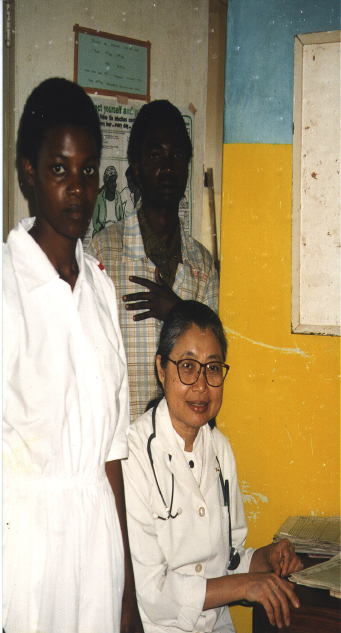
Sr. Rosalinda recalls her trip back to Africa where she is the only Filipino in an Irish Congregation of Sister Doctors.
My last holiday home to the Philippines was a great relief and a great rest but then the hour came to return to Africa. To be honest, I literally dragged myself to pack up my bags to travel back to Africa. I didn’t realize until then that I was spent and tired. It was difficult leaving home again now that I have only my remaining sisters Eulenia and Angeline. Papa was called to his ‘final home’ since my last home leave. Long before that was Mama, followed later by my brother Ruben. As Eulenia said, we will be three years older on our next reunion.
With the new set-up at Ninoy Aquino International Airport (NAIA), my sisters had to leave shortly after seeing me off at the departure gate.
I boarded the British Airways (BA) flight to London Heathrow Airport and even before reaching Hongkong, the first stop-over, I was already feeling homesick. I prayed the Rosary and feel asleep most of the time during the journey to London.
“Do not be afraid. For I have redeemed you. I have called you by your name. You are mine. Should you pass through the waters I shall be with you.” (Is 43:1-2)
Tuesday
After some hassle in London over my ticket to Holland, I reached Amsterdam Schipol Airport safely. It was raining heavily and the temperature was 9° C. I had enough time to buy some presents of chocolate sweets for my MMM Sisters at the Duty Free Shops then rushed on to the boarding gate.
On board the KML plane to Dar es Salaam, the capital of Tanzania, Fr. Hans Peters greeted me. He was returning to his mission in Mabamba. It was good to have company. We arrived before midnight at Dar es Salaam Airport. The temperature was 25°C.
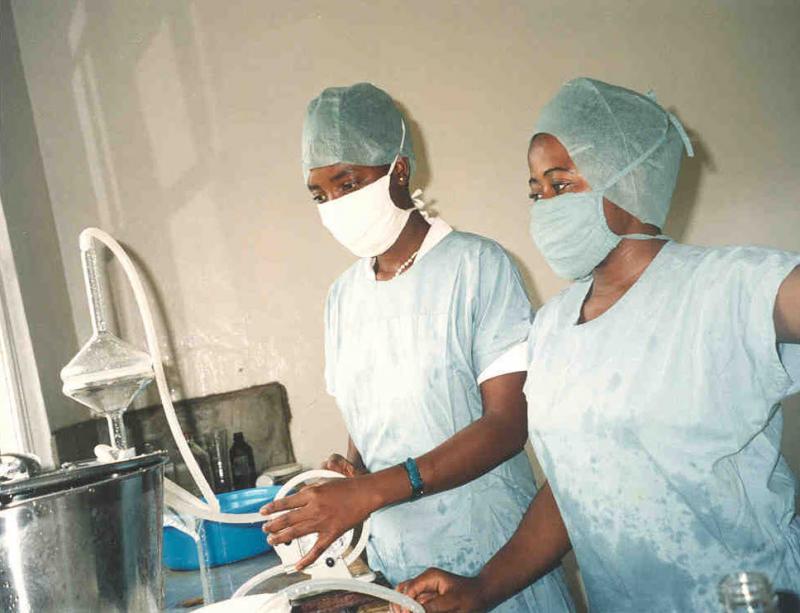
Wednesday
It was past midnight when we collected our luggage and went out of the Airport area. Fr. Vic Missiaen met us and brought us to our lodgings. There was a five-hour difference in time between Dar es Salaam and Manila, so I tried to shake off the jetlog by resting the whole day. Messages from Kabanga Hospitals awaited me to do some errands while waiting from my flight to Kigoma on Friday. Meanwhile I heard that Kigoma was almost isolated by the terrible flocks.
Thursday
Fr. Vic offered his car and his time to help me buy medicines and books, follow up certain applications and papers, delayed freighted medicines and supplies. At the end of the day, we even had time for an ice cream.
Friday
Having arrived very early at the airport we were told, to our great disappointment, that our flight would be delayed. At 12:45 pm we were told to board the plane and landed at Tabora Airport for refueling. It was the first time in weeks that a plane was able to land there due to flooding. After the brief stop-over we were airborne again enroute to Kigoma but the heavy thunderstorm, as we were about to descend, made the pilot decide wisely to return to Tabora and try to the next morning. It was already 5:00 pm and the passengers were billeted to a hotel. Fr. Hans invited me to go to the Pastoral Centre which is run by the White Fathers. It rained heavily during the night.
Saturday
We landed safely in Kigoma Airport at 10:00 am. The parish priest, Fr Paul Kibada, met us and brought us to the mission.
Sunday
I booked a seat and space for my luggage. Praise the Lord. At night over the radiotel, Sr. Patricia informed us that the hospital car will come on Monday.
Monday
Driver Agostino arrived without a car at the mission having already bought 2 new fan belts. The hospital car had broken down and he got a lift to reach us in Kigoma. We both got into Fr. Fideli’s car and traveled to where the car and broken down. Agostino mended the car and returned to Kabanga later while myself and Sr. Fidela were brought home to Kabanga by Fr. Fideli.
Tuesday
I was back to work.
“The Lord has carried you as a father carries is child all along the road your traveled.” (Deut 1:31)
Behind The Bamboo Curtain
By Gee-Gee O.Torres
 In 1975, Saigon fell to the Communist forces of North Vietnam. The image of the US embassy staff being helicoptered out dramatically at the last moment had been immortalized in the musical Miss Saigon. Then a bamboo curtain fell in front of the land of rice paddies and pagodas. Inside the curtain a large Catholic population shuddered in fear of what lay ahead. Would it be the end of the Church?
In 1975, Saigon fell to the Communist forces of North Vietnam. The image of the US embassy staff being helicoptered out dramatically at the last moment had been immortalized in the musical Miss Saigon. Then a bamboo curtain fell in front of the land of rice paddies and pagodas. Inside the curtain a large Catholic population shuddered in fear of what lay ahead. Would it be the end of the Church?
A quarter of a century later our editorial assistant, Gee-Gee Torres, ventures behind that curtain to report to the readers of Misyon. Naturally she has had to change names places for security reasons, but I think her story loses nothing in the telling. (Ed)
The flight from Cambodia to Saigon, now called Ho Chi Minh, took only 55 minutes. However it seemed hours to me. I knew my friend Ty was going to meet me at Tan San Nhat Airport. But I felt nervous. I was only relieved when I saw him smiling and holding a “Welcome Gee-Gee” banner outside the airport.
Bicycle Power
He helped me find the place to stay and introduced me to my Vietnamese guide, Thu. The next day I asked Thu if I could possibly visit a Sister’s Convent. She said, “No, problem” and off we went. I tried my best to keep still at the back while Thu maneuvered her motorbike out of the traffic. I was scared like the little boy riding at the back of a bicycle beside us. He was clinging tightly on to his mother’s waist while she was getting ready for the green light. Young ladies on bicycles wearing white ao dai – Vietnamese traditional dress – caught my attention among the motorists. They pedaled sedately and weren’t intimidated by the big noise trucks right behind them nor by the speeding motorbikes which crossed their lane.
Chopstick Lesson
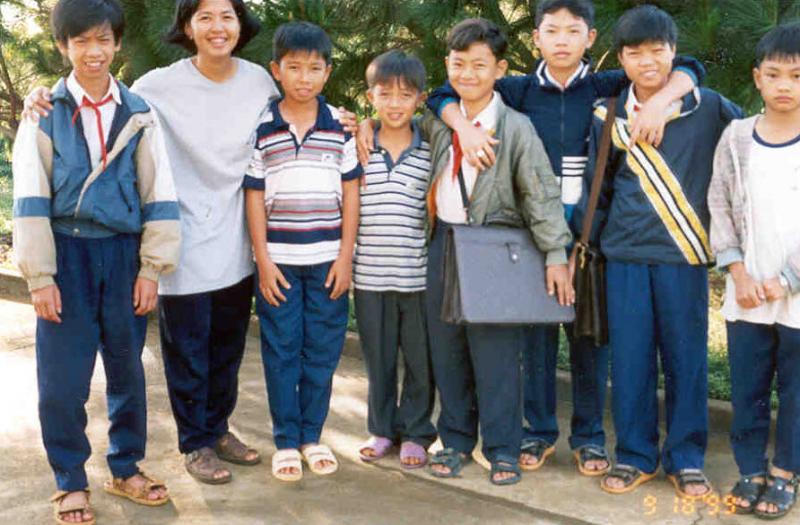
Gee-Gee with school children in Bao Loc
We finally escaped the traffic. We had breakfast at Binh Than Market where you could find all sorts of things – from fruits & vegetables to hardware. I tasted the popular Vietnamese breakfast – noodles topped with beef, mint and kangkong leaves. Thu couldn’t stand watching me struggle with the chopsticks. Eventually she offered to help me and I gladly accepted.
The Calvary of Sr. Hang
I met Sr. Hang at the convent. She has been a sister for 30 years now. She showed me around the convent and pointed out a building which once belonged to them but is now a government school. Then she narrated to me the following:
Before the fall of Saigon I was teaching in our kindergarten and elementary schools. However in 1975, all our properties were taken from us and the government took over our classes. We sisters were allowed to stay and live in the convent but our aspirants had to go back to their home villages. All over Vietnam the churches were forbidden to ring their bells. The government claimed that the bells were putting psychological pressure on Catholics to come to Mass. So the bells went silent. But, lo and behold, the people still came. It seemed that by word of mouth, in whispers and in secret, they passed the message of the time of the Mass on and they were indeed more faithful than ever. The churches were filled up as of old.
The traditional money in Vietnam is called the dong. When the communist took over they did what Marcos did. Overnight the government devalued the money. They created new money. They had a new Vietnam Dong (VND). Even if we had some savings they were now worth nothing. We suddenly found the old dong useless. In the convent we Sisters, now out of work, were given 200 new Vietnam dong and were told to make our way in the world. VND 200 then was only enough to feed our community for a month. (at present $1=VND 14, 000)
Our community decided to keep this money for our medical needs. We went out to work in the fields and garment factories to earn a living; we planted vegetables in the backyard to sell; we ate rice mixed with cracked corn to survive. We were also given a ration ticket which entitled us to buy our basic household needs. For example, we could only by a yard of cloth and a kilo of meat once every month. Sometimes we couldn’t help but laugh when they would give women’s clothes to men they who wanted a new pair of pants or would give a motorbike tire to somebody who needed a new bicycle tire.
Before the war a father could support his family of ten, all the children went to school and the mother just stayed at home. But after 1975, they could hardly eat even if all members of the family were working.
In 1990 the government allowed us to teach again. Our convent re-opened and hundreds of young sisters candidates are in training. Today there are about 7, 400, 000 Catholics in Vietnam, 10% of Vietnams population.
Suddenly I heard myself saying, “Now, I understand.”
“No, you don’t. What you heard is just 1% of what happened,” Sr. Hang countered.
Colonial Past
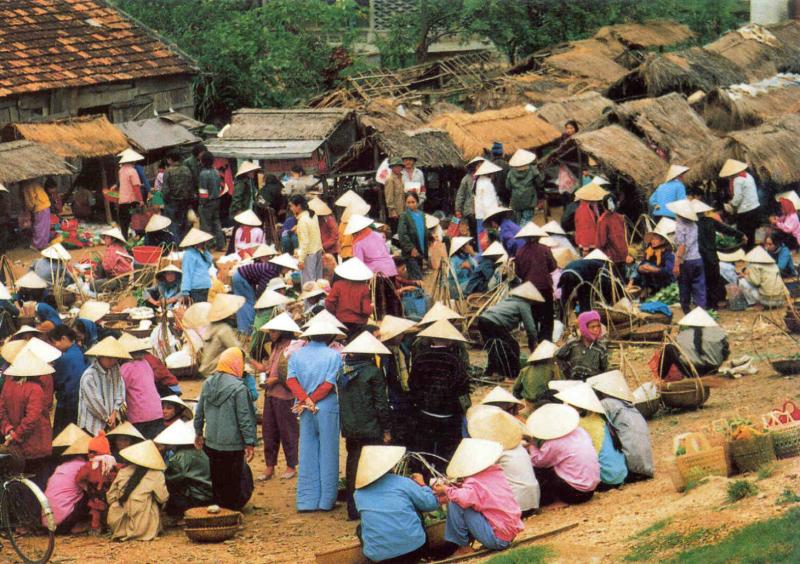
The following morning I took the plane to Lam Dong Province. Another Vietnamese friend, Krystal, met me at Lien Thuong Airport. She brought me to Da Lat City, dubbed in the old days “Le Petit Paris” of Vietnam. We passed through zigzag roads lined with pine trees. There were many flowers and vegetable plantations along the way. The higher we got, the colder the temperature. Just like our Baguio City in the Philippines. I asked Krystal why almost all of the houses here are of French architecture. She said that the French imperialists built vacation houses here during the years when Vietnam was under French colonial rule.
Full Churches
The next day, Van Van, a friend I met in Thailand, invited me to visit his place in Bao Loc – 85 kms away from Krystal’s place. In recent years the government has allowed a free-market economy so things have changed and people can now acquire properties, just like Van Van’s family who now owns a four hectare coffee plantation. He said that coffee is one of the main products in Vietnam. At least 400, 000 tons are exported every year.
Breath-taking Trip
To my delight he offered to bring back me Saigon on his motorbike the next day. Before we left for Saigon I attended the 5 am Mass in Bao Loc. I left the house at 4:30 in the morning with a group of young boys who were also on their way to the Church. The Church was nearly filled though it was only a daily Mass. I saw mostly old people because the younger ones go to Mass in the evening after school or work. The old women looked beautiful in the ao dai and bandana. I was about to sit with the boys on the pew when Han, the eldest in the group, to me to sit of the left side. I said, “No, I will just join you.” But he insisted that I stay at the other side, explaining that in Vietnam during the Mass men and women sit separately. Interesting. That’s how it was in the Philippines in Spanish times.
The trip from Bao Loc to Saigon was tiring. My hands went numb holding on to Van Van’s shoulder all throughout the five-hour trip. I wanted to stretch my hands, but I was afraid I would fall off the motorbike. The scenery along the way was breath-taking. Mist spilled down from the mountains and hung low on the dark green hills which looked like a tapestry designed with coffee, tea and pine trees. When we were passing by Dong Nai, Van Van said there are about 40,000 Catholics in this province and most of them came from the North. We also passed-by a mountain of covered with banana plants. “The Banana Republic trademark must have originated here,” I joked to myself and then I remembered that that was one of communism’s aims – to rescue countries from Banana Republic status!
Off to Ha Noi
From Saigon, I went up to Ha Noi (the Vietnamese words are normally broken in syllables like this) I planned to take the train but my Vietnamese friends advised me to take the plane. They said that the train ride would take 36 hours and I could not speak Vietnamese except for cam on which means Thank You, not to mention that I was traveling alone.
In Ha Noi I met Thuy who helped me plan my itinerary. She arranged with her trusted motorbike driver to bring me everyday to the different places on my list. I visited St. Joseph’s Cathedral where I met Cardinal Pham Dinh Tung. He’s the third Cardinal of Vietnam which unlike China has diplomatic (if tense) relations with the Vatican and Catholic Church. He initiated the first youth group in the Archdiocese of Ha Noi in 1998. The youth group has about 1, 000 members from the different parishes in Ho Noi. They have Catechism and Mass for the Youth once a month.
Cultural Miracle
Thuy suggested that I should visit Phot Diem, famous fro its Catholic Cathedral built in Buddhist-pagoda style. At first I hesitated because it is three hours away from Ho Noi and I would find myself again in the middle of the traffic just like in Saigon. But in the end I decided to go and it turned out to be one of my unforgettable memories of Vietnam
Seat of the Diocese
Phat Diem Cathedral is exquisite. As I entered the place, I felt like I was in ancient times. I saw a lake in front of a majestic bell tower, then the cathedral proper with five separate chapels and three grottoes around it. I was amazed at the intricate stone and wood carvings, depicting stories of the life of Jesus, Mary and Joseph, inside the Cathedral and the chapels. According to Lich, my Vietnamese guide, the Cathedral was built in 1891 by Fr. Tran Luc, more popularly know as Fr. Six, the then parish priest of Phat Diem. It took Fr. Six more than ten years to gather all the construction materials to build this Cathedral – the seven-ton slab wood for the pillars, the 20 ton slab stone for the altar. This simple parish eventually became the seat of the new diocese in 1901.
Ahead of His Time
The farseeing Fr. Six anticipated the present theology of inculturation and integrated the Catholic faith in the native Vietnamese culture through this unique architectural masterpiece. It resembles as Buddhist temple or pagoda, characterized by several tiers of overhanging curved roofs and adorned with images of saints. It has been recognized by the Ministry of Culture in 1988 as a cultural heritage of Vietnam.
Growing Vocations
Lich introduced me to Bishop Yen of Phat Diem. Vocations in Vietnam are growing. Some 200 candidates await to enter the seminary in every diocese. But each diocese of the country’s 25 dioceses is only allowed by the government to send eight candidates for priesthood every two years. In case a candidate changes his mind or is dismissed from the seminary no replacement is allowed. The government decides who to ordain and when.
In 1954 each diocese had its own seminary but now, for example, in the north there are 8 dioceses but only 1 major seminary. Each parish then had three priests but now two to three parishes only have one priest.
Bells Ring Out
At present the government has loosened some of the reins once tightly held over all religious. Churches are open; Catholics can hear Mass and received the Sacraments. But the Catholic Church is still restricted. Despite this, the once-silenced bell in Phat Diem Cathedral rings out and it is heard all over Vietnam.
CAM ON
Cap & family, Monique, Ty, Van Van, Chinh, Han, Sinh, Krystal, Phuoc, Lam, Tam, Huong, Hang, Phuong, Hin, Thuy, Hoan, Lam Ngoc, Van, Thai, Thanh, Lich, Yen, Nikki, Lia, Junji, Tom, Charlie
Thank you
Channel Of Peace
By Fr. Philip Yu Jr., cicm
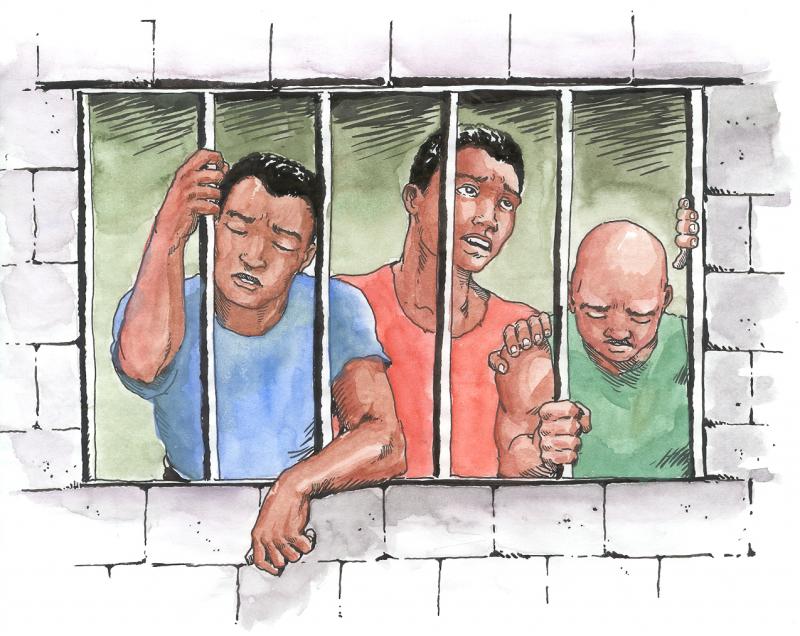
Our seminary in Zambia is composed of small traditional huts made of mudbricks and thatched roofs. I love the work of helping to ‘form’ the young Ghana seminary but recently I have plunged into another apostolate at the side.
Death Row
For more than a month now, I have moved on to a new involvement at Mukobeko Maximum Security Prison, particularly at the Condemned Section (death row). How I got myself into it was like a nightmare to me. My retired priest companion, Fr. Wim Goosens, replaced the prison chaplain while he went for a long leave. But Fr. Wim got sick and I had to replace him. The idea itself of being among the prisoners at death row overwhelmed me!
One with the Prisoners
On the first day that I was in prison I was so stunned; I couldn’t believe I was there. My very first time to celebrate the Holy Eucharist at death row was an experience I could never forget. I was in the midst of 52 Catholics prisoners and there we were, squeezed in the very small death row corridor celebrating with joy the Holy Eucharist. It is indeed draining psychologically because I see my presence to bring hope in the midst of despair, joy in the midst of sorrow; but the problem is, I also get caught up with their desperation. There are those who are condemned to death for a crime they have never committed. In the last execution made, two of the five executed were completely not guilty. Still the same there is the concern for justice and peace as well as issues of human rights.
Errand Boy
I also do errands for them like buying bath soap, laundry soap and sugar from the common fund I’m keeping for them which was given to them by some of their friends and supporters abroad. I also look for benefactors for prizes of their varied tournaments to keep them preoccupied apart from the skills that the prisoners are learning. Some of them are even continuing their grade school studies despite the limited books they have in their library. Some are doing correspondence courses paid by their supporters from aboard. For the prisoners, even among Catholics, it does not matter to whom they can write as long as they can get some assistance be it in kind or in goods. As Catholics our church is very poor in providing assistance. So now I even have to double time in looking for resources not just for us here in the seminary but also for the death row prisoners.
Why this, Lord?
Given this situation I am still very happy being with the prisoners. Tiresome but very fulfilling and challenging. Here I experience the prayer of St. Francis of Assisi as a reality (Make me a channel of your peace...) and the Gospel of Luke 4: 18-19. Once I laughed at myself because when I started my ministry as a Formator here, I used to help out in some parishes nearby at weekends as gap-fillers for Sunday Masses and there was really something deeper that I longed for. I continually prayed for a more meaningful pastoral involvement than just being a gap-filler and then, unexpectedly, I had the death row before me. God must be confused I asked Him to give me a more meaningful involvement and now that He has granted it, I say to Him, “Why this Lord?” I just sound like all the others in the Bible, Jeremiah and Job.
Life Is Beautiful
By Fr. Niall O’Brien, ssc
I hope you have seen Life is Beautiful. But in case you have not, the plot goes like this: Italy, 1939, young man falls in love, he is Jewish, she is a Catholic. Italy is in alliance with Hitler’s Germany and has been infected with German racism – seeking the pure Aryan breed, superior to everyone else. Everyone is swallowing the new ideology. Well, not everyone, Guido, our hero, laughs at it, naturally, because he is a Jew – one of the “inferior” races.
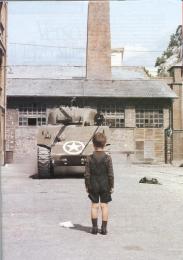
Just a Game
Well, as I said, he falls in love and he and his wife and their child end up in a train going to a concentration camp – or I should say extermination camp – in Germany where as members of an inferior race they will be liquidated. Little Joshua-it’s his birthday – demands to know what is going on. Guido explains that it is all a game; if they can obey the rules of the game they’ll get so many points and win. Follows the usual heart-breaking ordeal inside a German did extermination camp. [This is not fantasy; the Germans did exterminate six million Jews.] But this time it is made so much more poignant by the hilarious antics of Guido as he tries to convince his child to put up with the horrors because it’s all part of game; in the end he will win.
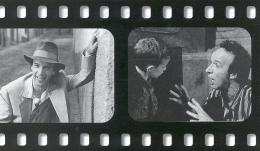
Too Much Reality
There are loads of movies made about the Holocaust. Schindler’s List for one but somehow the story is so sad we resist; it is too much for us. Human being can only take so much reality. Here, by mixing in laughter and comedy, the director Ricardo Benigni (who is the main actor and co scriptwriter with Vincenzo Cerami) actually gets the message across more deeply though I have heard that some Jewish groups were angry with the film. Well you can’t tell people how they should feel but this movie will be remembered long after other movies on the Holocaust are forgotten.
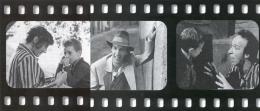
A Metaphor
I’m not going to tell you the whole story and the extraordinary twist at the end nor can I share with you the tears and the laughter; you have to see it for yourself. But I can share with you the wisdom, the metaphor, the beautiful metaphor for life that this movie is. Guido is not deceiving his son about the game. In the end we see that life is a game. We all get dealt with different hands. We do our best but we must play the hand we are dealt. Though we can pick up and discard and that’s where free will comes in. We will not be judged on the physical results but we’ll be judged on how we played the hand we were dealt. If you have become blind in mid-life, if your husband has walked out on you, if your favorite child has made a bad marriage, you still have to live as best you can with the cards you were dealt and as Guido would say, “No complaints. Life is beautiful.” It’s how you live that life that counts and the movie shows you how it is done.
He Made Life Beautiful
So winning is not in being successful. Winning is living with integrity and faithfulness and doing what is right though no one sees because you believe that He who made life made it beautiful and you trust Him that all that happens is for your good. Surely that’s what He means when He says, “Sparrows are sold for a few centavos. Not one of them falls from the sky but your Father knows it. You are worth more than many sparrows; O you of little faith!”
Our Bodies Across The Road
By Sr. Xavier Marie Bual, spc
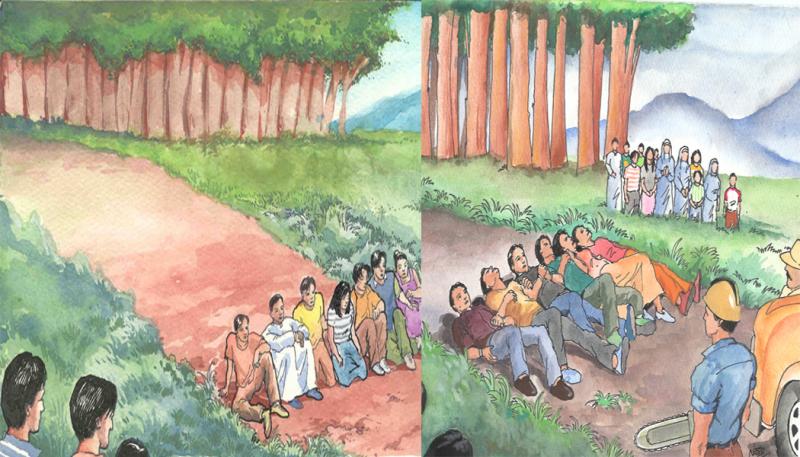
Lanao del Sur, Which holds the beautiful Lake Lanao that empties to the North through Lanao del Norte at the majestic Maria Cristina Falls, is the main source of electricity for most of Mindanao, generated by the falls’ hydroelectric power plant managed by NAPOCOR. Lake Lanao is surrounded by untouched forest to the east, south and west. The southern area extends its forest far to the south of the province near the boundary of North Cotabato particularly the mountains of Wao which is the last municipality of Lanao del Sur. The main product of the area is corn, planted on rolling hills extending beyond the boundary to North Cotabato. Their area used to be covered with thick forest. The loggings companies cut these forests, built the roads and connected the small towns of Bukidnon, Lanao del Sur and North Cotabato. There is no road that cuts through the forest around Lake Lanao. This is precisely to protect the watershed of Lake Lanao.
Obvious Effects of Loggings
Recently, a big landslide covered the highway to Wao at the boundary of Bukidnon caused by the daily afternoon rain. The people of Wao considered this landslide a sound of alarm at the possible effects of the on-going cutting of trees up the mountains in the forest that forms part of the watershed of Lake Lanao. If the watershed is eroded it will bring about the gradual lowering of the water of the lake which will eventually run out of water during the dry season and will cut down the electric source in Mindanao and cause floods during they rainy season.
Church People on Barricade

The parish priest and leaders of the Basic Ecclesial Communities of Wao decided to do something to stop the logging of their forest. They put up a barricade at the crossing of the barangay road that leads to the logging area and the national highway. Last July 12 a meeting was convened by the president of the diocesan clergy of Bukidnon to solicit the support of the local officials of Wao for the barricade started by the local church, Two weeks of rotation of BEC cluster leaders watching the barricade encouraged the priests of the churches of Malaybalay Diocese where Wao belongs through ecclesiastical arrangement. The priests of the Diocese supported the move of the local church of Wao by joining the leaders of Wao at the barricade site. The move was done by the religious sister of Bukidnon where they scheduled their presence at the barricade, two to five sisters at a time (two days for each group) at the barricade, for two weeks. There were about 300 people present representing the parishes of Bukidnon, RSP and organizations and NGO’S from Bukidnon, Lanao del Norte, Aguisan del Sur and del Norte, Davao, Cagayan de Oro.
“There’s nothing we can do!”
The mayor and his bodyguards as well as the barangay captains of Wao were requested to air their opinions about the move of the parish to oppose the cutting of trees in Wao mountains after the facilitator had explained the objective of the meeting. On the whole local government officials were concerned about the logging in the area and wanted it stopped. But they also expressed that they cannot do anything to stop it as the concessionaires have a permit to log the trees of Wao. They support the move of the parish but will follow orders from higher officials when specific orders to haul the logs to Cagayan will come. They therefore asked the parishioners (church leaders) to hold the barricade only up to the time when orders from higher officials to bring the logs to Cagayan might arrive.
Stick to the Fight
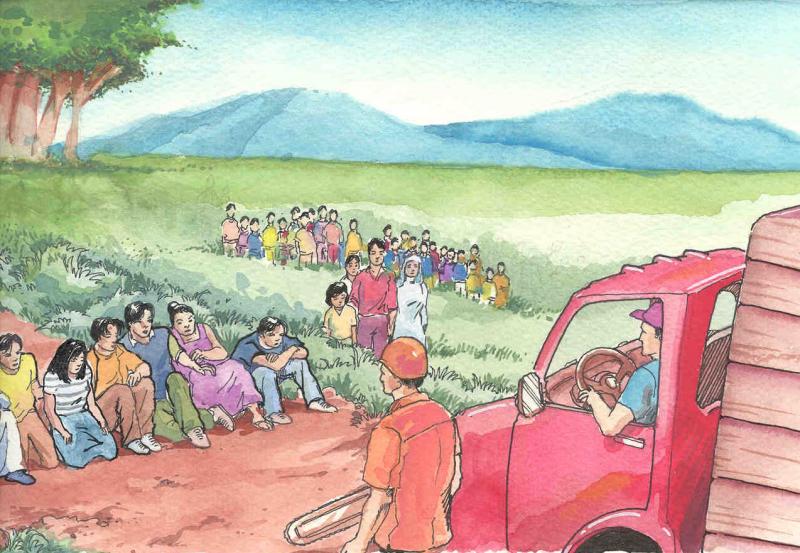
After the dialogue between the local government officials and the local church was adjourned, the core groups of the parish met with the visiting priests, sisters and NGO’s supporting the barricade and had a short meeting to clarify the stand of the parish leaders now that they know the stand of the local officials.
The parish leaders have decided to continue to stop the hauling of the logs even if orders should come from higher officials to allow the logs to be carried to the log pen at the Macajalar Bay in Cagayan de Oro. They have decided to stick to their earlier decision to stop the hauling of logs and to stop the cutting of trees and to have the permit to log in Wao be cancelled. They have therefore asked for the presence of the media when the time comes for them to lie down on the road to stop the trucks from passing the barricade with their own human bodies.
Without a total log ban, the cutting of trees will go on and on till not one tree is left standing.
Restoring The Years Which The Locusts Have Eaten
By Claire De Brit
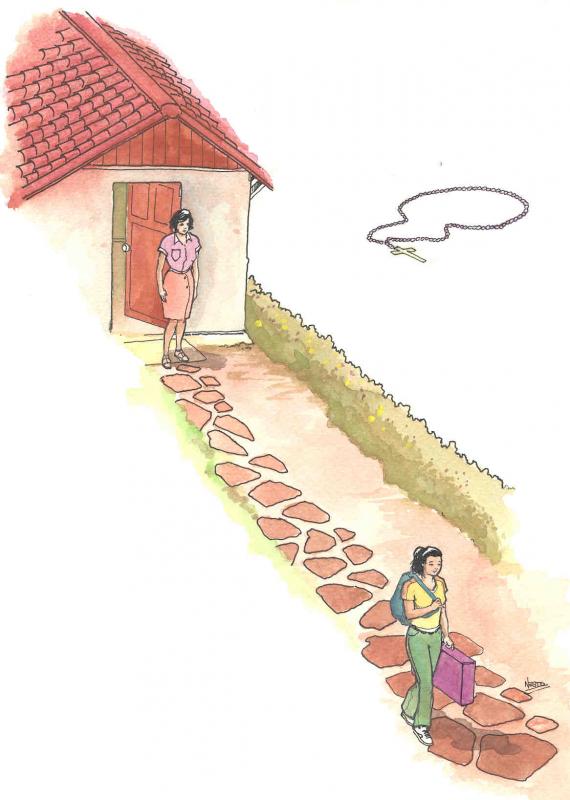
The author of this little life story, Claire De Brit, has been through her own spiritual journey, a journey which at times involve darkness and suffering. But in recent years, Claire feels that she has come out into the light. Her youngest child made a decision which Claire felt was going to destroy her life. This new light helped Claire know what to do. Here she tells us the simple tale which will mean so much to some mothers and fathers who read this.
When I was a child my family said the rosary every night – on our knees, faces into chairs and off we went. My memory of this is of impatience and feelings of utter boredom. I was restless and ill-at-ease. As I grew up and eased away from the family circle I also eased away from the rosary. In school when the nuns recited it I automatically turned off; I had absolutely no interest at all and found it long and boring. Then I married, and had three children and we never recited the rosary. However as time went on and I began to slow down a little bit I would hear the rosary prayed in my local church. It seemed to have a new sound and I felt drawn a little at a time.
Helpless
Well, one day my youngest daughter left home to live with a man I knew wasn’t for her-- he is a good person but too old and in a different world. I tried everything to prevent her making this very serious mistake in her life and it was of no effect. Gradually it dawned on me that I could do no more. I felt helpless and powerless and started to pray. The thought of the rosary came into my mind. I had an old rosary beads from the years back and I felt I couldn’t get them into my hands fast enough. And thus I prayed feeling each bead intensely and surrendered my beautiful daughter to the greatest Mother of all -the Mother of God. I knew that Our Lady had taken away my fears and that my daughter was safe. My job was to let her go into the hands of our Heavenly Mother.
Inner Light
The next day I was in my local church and heard the rosary being recited. I joined in and it seemed to come alive for me. I was beginning to understand the inner light of the prayers. Each day I am learning more of the beauty and the story of the life of Jesus and His Mother and gradually I feel healed and the words of prophet Joel come to mind; “I restore the years which the locusts have eaten.” (Joel 2:24)
The Big Banks Laughed
For 40 years Fr. Sean Cannaughton has grappled with the problem of poverty. Then one day he heard of the Grameen Bank. In an interview he tells us about it here.
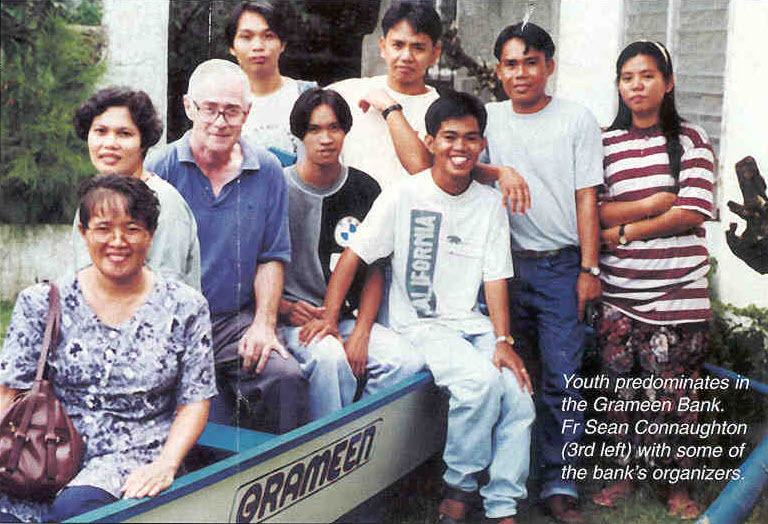
Q. Who was the founder of the Grameen Bank?
It was founded by Professor Muhammad Yunus. He was the head of the Department of Economics in Chitagong University in Bangladesh. In the Bengali language the word grameen means rural village. This village bank differs radically from most banks we know. For Professor Yunus, the Grameen is a bank that comes to the people. He retained the name ‘bank’ in the hope of transforming the meaning of the term.
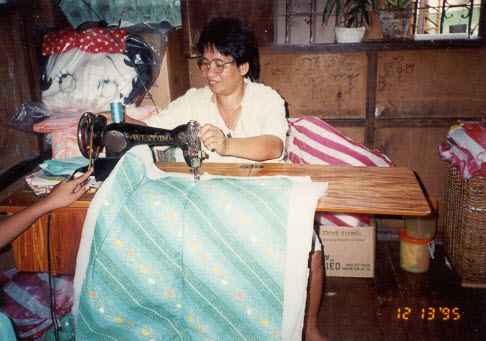
Q. What led him to set up the bank?
A. He began to see his university career like life in the cinema. The film ended once you got outside the gate. When class was over he walked home through streets full destitute people. The contradictions came to a head during the famine in Bangladesh in 1974 when he experienced the inability of the academic world to do anything. He began to travel throughout the country asking questions and observing what was happening. During that time he worked out the basic framework of what became the Grameen Bank.
Q. How did he translate his ideas into practice?
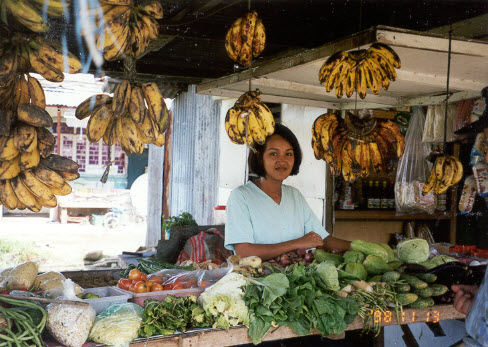
A. He began with a woman selling bamboo stools on a street corner. She bought the materials from a local store and then sold the stools to the store to pay her debts. She was left with almost nothing. It was slave labor. He lent her the money for the next purchase of raw material on condition she paid him back. She prepaid the loan on time. He persuaded the university students to put up about £1,000. All was loaned and returned. Then the university put up a bigger sum which was loaned and returned. When he asked some banks to make loans available to the poor they laughed at him. So he decided to found a bank himself. The membership in Bangladesh has risen from a million in 1991 to over three million today and has improved the lives of 15 million people.
Q. How did you get involved in the Grameen Bank?
A. During the 1970’s I was chaplain to a number of universities in Manila. As part of the student summer projects we used to run seminars training people how to set up livelihood cooperatives. We set up 26, many of which still flourished today. But I noticed that within six months 30% of the participants were forced to leave for lack of money. They could not keep up payments of the fixed deposits and saving deposit, or put up the necessary collateral required by the cooperative. (In simple terms the collateral is the guarantee behind the loan. If the borrower failed to pay up, the co-op had a right to claim his/her radio, for example.) In 1989 while doing some studies in the University of Sussex, I met people from Bangladesh who spoke of the Grameen Bank, a system that seemed to be just the kind of thing very poor people need.
Q. So you changed from promoting cooperatives to the Grameen Bank?

A. Yes, with the result that in many areas where we formerly set up co-ops there are now much more successful Grameen Banks. On my return to the Philippines in 1989 I talked the idea with other people, university professors, businessman, a forestry expert. We decided to set up the Grameen in Jala Jala, the area where I then worked. By Lucky coincidence Professor Yunus visited the Philippines and also visited our parish to give encouragement. By 1993 Jala Jala had ten centers and 300 hundred members. I was also able to spend a month in Bangladesh observing the system.
Q. How do bank organizers present their objectives?
A. Basically as agents of change. As the movement grows we hope to change the attitude of commercial banks. When we asked the First National Saving Bank recently for the loans they offered it at 28% interest – as bad as the money lenders. Funds given to the Filipino government by other countries for the alleviation of poverty are available to us at 12% per annum provided that 95% of the capital is repaid annually. This is too much for the people who most need it.
Q. How do you go about setting up a bank group?
A. The condition for initial entry to a group is that the applicant must be poor and be committed to the observance of the rules such as repayment of loans and attendance at weekly meetings. Maybe 100 people will turn up for a fist meeting. Then they are told that they will be divided up into groups of five (who know each other very well) and if one fails to pay the weekly installment the other four will have to cover it. About half lose interest.
In the following six training sessions the basic principles are studied. These are designed for our local situations and cover. Areas like work-discipline, home hygiene and education of children. At the end of the sessions there is a formal event. Participants dress up and invite their friends to the final oral exam called the Group Recognition Test, where they are individually questioned about the 16 basic principles. They worked hard in order to put up a good show. If one of the groups does not pass their test all must start all over again. A key objective in the initial course is to teach respect for money. Two participants were forced to get rid of their gambling machine before they were allowed to join because it represented of lack of respect.
The next step is for the group-of-five to determine their projects. One might say “I am going to raise chickens.” Another “I am going to make nets” and so on. The group then discusses the individual projects. It might be objected “You don’t know enough about chickens, do something else.” The others are aware that they will have to pay for the irresponsibility of a member. A Fundamental Grameen principle is that one cannot, for example, seize the gas cooker of a woman who makes her living by cooking with it, even if she cannot pay her installment. The group has an Emergency Fund, into which everyone must pay something, to help with, for example, a sickness. There is another Group Funds to help with other seasonal needs like school tuition.
Projects are approved by the group and then by the branch office. Money is granted within a week of approval. The group-of-five then come to the office, make a promise, and receive the money. They are given two weeks to set up business. Subsequently, at all levels, a check is left on loan utilization. People who have been eliminated from the program for misuse of funds often reapply later and are accepted. The second time around things generally work out. Group pressures ensures a high level of responsibility. The first year there are often failures and fund abusers. After that almost all are filtered out.
Q. Does anyone ever say ‘That is peculiar sort of job for a priest to be involved in’?
A. It was the dire poverty of the places I lived in that brought me into this kind of work. Even today the daily wage of many of the people we work with wouldn’t buy a kilo of fish. We stared the co-op in the Manila squatter settlement of Tondo with 200 pesos. To date it has lent 35 million pesos and improved the lives of many poor people. Its 900 members are a core of the local economy. In 1997 the mayor of Manila gave Tondo an award for being the city’s outstanding co-op. A bit of capital put into the hands of the poor can transform both individuals and community in which they live. Things that take place ‘inside’ the church are obviously important. But if people are literally dying of poverty and scourge with delinquency something more is called for. I believe that if justice is not being promoted the Gospel of Jesus of Nazareth is not being preached.
(The Far East)
The Women Whom Korea Should Mourn
By Sr. Minerva Dangaran, ssc
Sr. Minerva Dangaran and Fr. Al Utzig have started a rural missionary community in Korea. They live like the farmers who till the land for their living. Here Sr. Minerva tells us about her first and last day in Potato field.
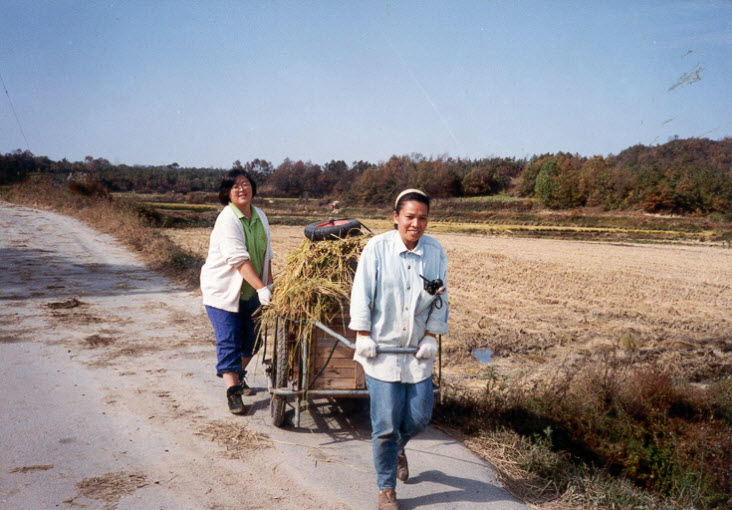
Our village has a work leader. We call him the Taejang. This leader organizes the women, goes around to pass the news for available work, negotiates with the field owner and receives money for the laborers.
Older Women
At the beginning it wasn’t easy working in the fields. I didn’t have to be rough and coarse but I needed to be able to take the roughness as a reality in the field to survive. Most of the women working in the field are in their 50’s to 70’s. The older women are quicker than us. (Sr. Monica, Sr. Kay and I). How ever these women do not qualify for factory work. It might seem strange to see older women in the field but social security for mothers depends on the first son. If he is not economically stable and cannot or will not support his parents, the mother tries to earn money. The available work for aging women is usually the low paying jobs and the agricultural labor jobs.
Courage in Women
Maybe some people seeing old, wrinkled, or emotionally broken women, bent and overworked in the fields world find this scandalous. But there are blessings to having company. These are also independent women, not only physically strong but survivors of many personal tragedies in life. They have ears to listen to the pains unveiled at times when they have time to be relaxed together.
Don’t like Planting Potatoes
I don’t work with the women everyday but I have worked with them many times I planted red peppers, cabbages and harvested peanuts and ginseng with them. The work that I don’t like doing is planting and harvesting sweet potatoes. I always refuse every time the Taejang asks. However, one day I wasn’t able to escape from it. That night she came and explained we would be working in an apple orchard. Kay Suk didn’t have time. Sr. Monica was working in the old folks home at that time. I went along with the women. One the way to the field, the Taejang told me that we were not going to the orchard, we were going to plant sweet potatoes. I didn’t want to proceed.
Chaos and Confusion
We didn’t start the day very well. We lost our way. There was miscommunication with the driver and the owner. We were brought to another field instead. At 8:00 in the morning we hadn’t found the field yet. The owner was waiting for us but we didn’t see him. Finally, after a long search, and so many telephone calls, the driver found the field. The owner was already angry. The tractor was waiting for us, too. We were late. There was a lot of shouting and instructing. The woman knew what to do. They put their bags in the shade, ran to the sweet potato boxes, put them on their heads and run to the prepared part of the field. Our Taejang also did the same shouting and instructing. The movements and instructions were chaotic. The women planted and the owner shouted again and they transferred to another direction.
Humiliation
I paused for a moment to see what’s going on. I observed that the way they planted was totally different from what I knew. I didn’t put the box on my head, I carried the box in my arms. The owner shouted at me. He said, “This married woman is strange.” When the Taejang explained to me how to plant the potato tops, everyone began to notice me. Unluckily the owner kept on saying on I was strange. Then he instructed me differently than the Taejang had. By then everyone was observing me. I Said to myself, “If I can endure these eyes for an hour I will survive.” One woman could not endure the way I planted. She told the Taejang that I didn’t know to plant. The many women were at me. I was getting angry. Finally I told the owner I was going back that I could not plant. I ran to my lunch bag and headed for the highway. Then Taejang shouting at me to come back but I ran faster, I couldn’t stay a moment longer.
Home at Last
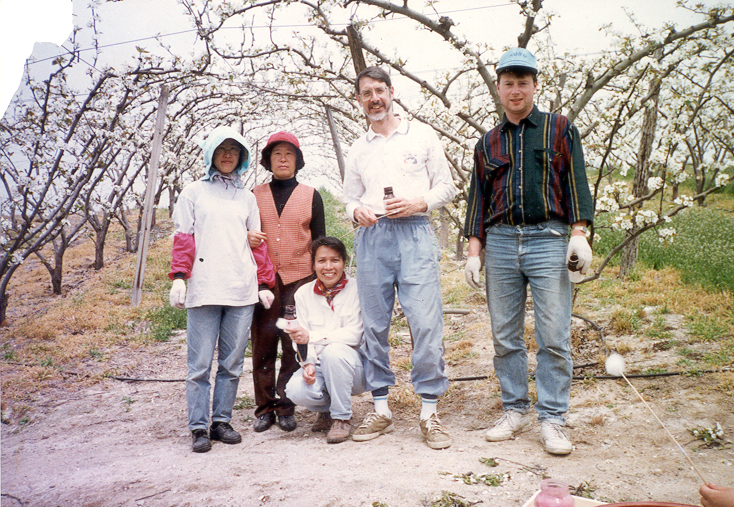
Sr Minerva with her Columban 'family'
When I reach the highway, I tried to stop the passing cars. It took me sometime before a car stopped. The old man asked me where I was going. When I got in I stared crying, the man asked me where I came from. I answered that I came from the Philippines. Then he sighed and said, “A foreign worker!” He slowed down the car and explained to me how to get back to our town. I was two towns away, almost at the border of another province. The old man took me to the bus stop. I got the bus right away. Everyone in the bus was so kind. The driver told me to go to another town. It was market day and I met some neighbors who asked me why I was early. I said that I ran away from the field. Five minutes later, I took the third bus, this time to our village. I was relieved.
From the bus I went straight to our field. Father Al and Sister Kay Suk were weeding the fields, preparing for planting. I told them my story. Sr. Kay said, “Now you can understand why I can’t go back go back to the sweet potato field? the owner is always at you, telling you to hurry.”
I was lucky I had enough travel money. After lunch I remembered the women I left behind. Some of them I remembered working with me in other fields. I realized their responses to the owner’s shouts and commands were either silence or a curse. I could leave the field, those women could not. It’s their life. I am free to leave the field – I am a foreigner.
These are the women whom Korea should mourn when they go to their eternal rest. These are the keepers of the nation. They are women who feed the whole nation. These women hold the wisdom of old, their knowledge of seasons and planting will be buried with them. Without them the nation would not have the vegetables planted nor harvested. Without hem there would be no precious fruits or flowers in the market stalls. Without them Korea would be less.
We Met In The South Seas
By Michael Dalton
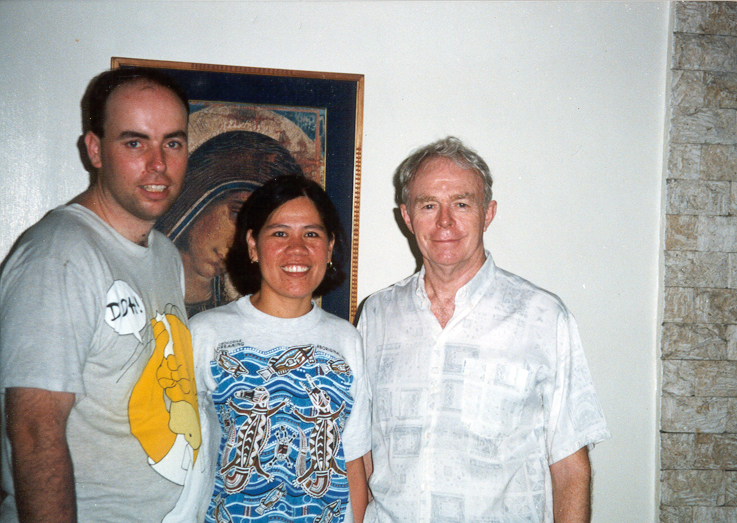
Enriqueta, once one of Fr O'Brien's community leaders, visits him at Misyon Office with her husband, Michael Dalton
In 1993, Enriquita arrived in Western Samoa to begin her role as a lay missionary at Paul VI College and as an Incola Mariae of Legion of Mary to share her gift and to learn about life outside the Philippines. After two years in Western Samoa she moved to American Samoa in 1995 to work at Fasso High School and work as Math and Science teacher for another two years.
At the same time I arrived at Paul VI College Western Samoa to replace Enriquita as a Math teacher. I came as a lay through the Australian organization, Paulian Association of Lay missionary Secretariat (PALMS). My reason for applying for PALMS was that I very much wanted to help the poor.
Getting to know each other
In August 1995, Enriquita went back to Western Samoa to visit her friends. It was during this time that we met and begun to get to know each other and share our mission experience and we came to a similar conclusion. We both wanting to help the people in Samoa, but in the end we found out that we had both been helped and changed for the better.
Learning about Happiness
For me personally, I learnt about happiness. Most of the students at the school would be considered very poor by Western Standards. Yet their ability to lose themselves in the moment and just be happy, I found so amazing, something I doubt I ever experienced in my childhood. I would watch the students after school play rugby (Samoan Football) and they would just laugh and laugh. Even when torrential downpour of rain came, they would even have more fun, sliding along the wet grasses.
Did We Make a Difference?
When we both look back at our time we can’t help but doubt whether we made any difference, but what in the end mattered was that we had lived these years of our lives with the people of Samoa and what had changed in the end was us.
In February 1997, we were married in Melbourne, Australia which is where we currently live. We believe the missionary spirit is still much alive in us and will always be. It is one of the crucial elements that unite us.
Whether we work again overseas or our mission becomes the raising of a family, we now place this in God’s hands.
Where God Leads Me
By Sr. Soledad Ladores, fmm
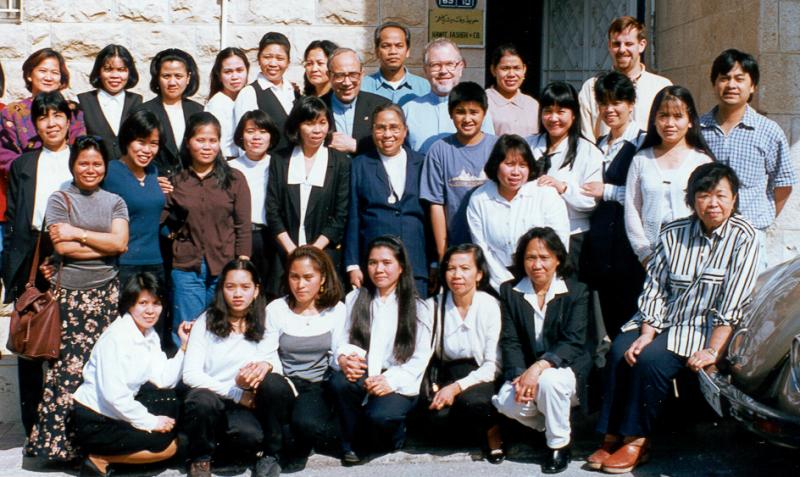
I came to Amman Dec. 5, 1984 after doing two years of Arabic Course in Jerusalem. I tried to help the sister-in-charge of the catechism classes in our parish but I realized that my Arabic was not good enough to do any apostolate among the Arabs. I was really searching for an involvement. One day, while on a visit to Jerusalem, a Filipino sister handed me a letter written by a Columban priest, Fr. Charles Meager, during his visit to the Holy Land in August 1984. I happened to know the priest as he was our parish priest when I was assigned in Iligan City in Mindanao. The letter read:
Dear Sr. Flor, when I was in Amman, I met a Filipino girl working in a hotel. Two things came into my mind. First, even though she is in Amman for four years, she has never been to the Holy Land. Is it not a pity that the priest or sisters in Amman could not arrange a visit for them to the holy places? I think it would be a good experience for their faith. Second, many of the Filipinos in Amman are in danger of falling away from the Church and their faith. They need ministry. Could you not push some sisters in a ministry to the Filipinos in Amman? It is really a great need.
This letter challenged me-after my home visit in summer 1995 I started to get involved with this ministry. I began to attend Sunday Masses as Jebel Amman where most Filipinos go for Mass. After that I met some nurses who lived in a dormitory nearby. One Sunday they introduced me to the parish priest by the name of Fr. Rafig Shoubash. He invited me to work in his parish, which I accepted with the content of my community.

The Filipino Center
With 15 members we started to form a choir to make the Sunday Mass more alive. We had no materials so each one tried to recall hymns they learned in the Philippines and sing it to the group for the liturgy the following week. Little by Little the group grew in number. Then it was divided into two groups, those who sing on Fridays and those on Sundays. Through the FMM community we rented a house where we could gather after Mass. We called it the Filipino Centers. Here we prepare meals together on Friday, Sunday and other feast. Our choir sings Jebel Webdeh and Jobal Amman Church and at Jabal Hussien for Christmas Eve and Holy Week services.
In Safe Hands
This center serves as a welcome house especially to those who have no place to go during their day off. This becomes their home where they feel a sense of belonging – they share not only their heartaches but also their joys to each other. Many employers are grateful that thier employees go to this center for they know they are in safe hands. Last March 1996, through the agreement between the Patriarch of Jerusalem and the Jesuits in Jordan, an English Language Parish was created. All the English speaking community in Amman belong to this parish, including the Filipinos. This is a blessing for us - we got our own pastor to attend to our spiritual needs – more so for me as I don’t feel alone anymore in my work.
Now after 13 fruitful years of ministering to my kababayans, I have to say goodbye to answer another call. I’ll miss everybody but this is what it takes to be a missionary. I just have to go where God leads me.
Who Will Climb The Mountain Of The Lord?
By Maricel Bedra
Today Catholic Ireland is going through a crisis. Undreamed of wealth has arrived along with a nightmare of scandals. Young people struggle to deal with the new reality. Some leave the church, some drift into indifference, a small but growing number even commit suicide. But some remain faithful and Maricel Bedra, a Columban Lay Missionary from the Philippines, joined these youthful people in an arduous pilgrimage of the Holy Mountain, the mountain of Patrick, the original apostle of Ireland. She shares the experience with us.
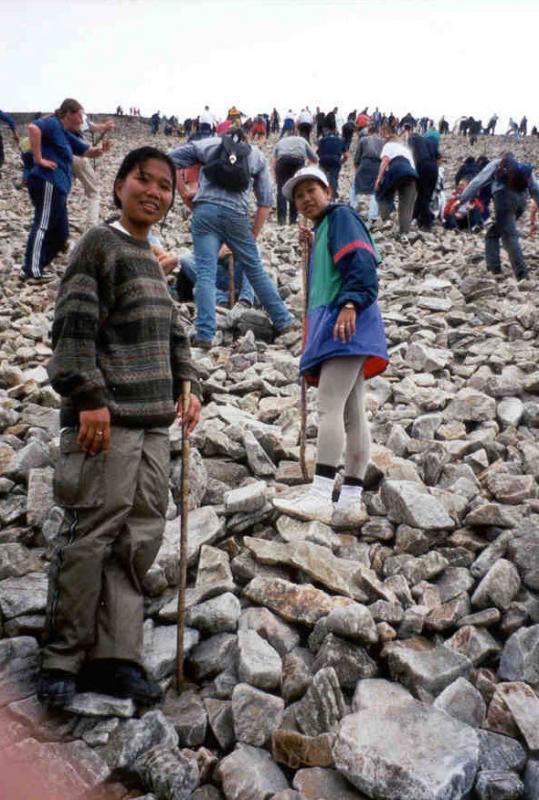
I had no idea how far 50 miles was by foot until I did it myself when I joined the four-day pilgrimage to the Holy Mountain of St. Patrick which was organized by the Columban Fathers. They have been organizing and inviting friends to join in this journey to renew our Christian faith which was brought by St. Patrick to the Irish people 1500 years ago. The invitation was appealing to me because of my interest in mountain climbing as my special way to commune with myself, with nature and with God.
We Started Out Few
The pilgrimage started in Knock, the National Shrine of Our Lady, with a Taize prayer led by a Jesuit priest. It was a mood setting, silent meditation and awareness of God and one’s self. We were just 20 on the first day and what’s amazing was that we were a multi-national group French, Fijian, Filipinos, Koreans, Scottish, Irish. It was exciting to meet new friends from other lands and as we went along the numbers grew.
Trekking through History
From Knock, we walked to Belcarra, 12 miles away, where we stayed overnight. The accommodation was great, the hosts were warm and hospitable – an experience of real Irish hospitality. On the way next day, we visited some ancient abbeys like Ballintubber and Mayo. These abbeys have a magnificent history of their own. A story of struggle, faith and hope during the dark years of persecution. Another station along the way that I really loved was Church Island, a small islet surrounded by water, where peace and solitude could be found. What struck me in that island was how they utilized every single creature to tell the creation and salvation story.
Goal: The Reek
The pilgrimage concluded on Sunday the long walk to the Holy Mountain, situated in the west of Ireland. We started early with the morning praise and some instructions given by the organizer, Columban Fr. Tom Murphy.
We arrived at the foot of the mountain ahead of time so we rested, had some hot food and drink and somebody started singing songs that helped to wake us up. I felt a thrill of the anticipation as we glimpsed the clear summit of the mountain far off in the distance, hoping to get there with sound body and spirit.
Stations to Complete
There were ‘stations’ on the way to the summit which is pilgrim tries to complete. The 1st station was at the base of the mountain which consists of circular mound of stones where the pilgrim walks around seven times, while reciting seven Our Fathers, seven Hail Mary’s and the Creed.
The 2nd station was at the top at a rock which is called St. Patrick’s ‘bed’. Legend has it that St. Patrick slept there. A pilgrim kneels down, recites the same prayers as at the first and walks seven times around St. Patrick’s ‘bed’ saying the prayers.
The 3rd station consists of three mounds of stones. A pilgrim walks around each of the mounds while reciting the seven Our Father, seven Hail Mary’s and the Creed. That finishes the stations.
Barefoot Pilgrims
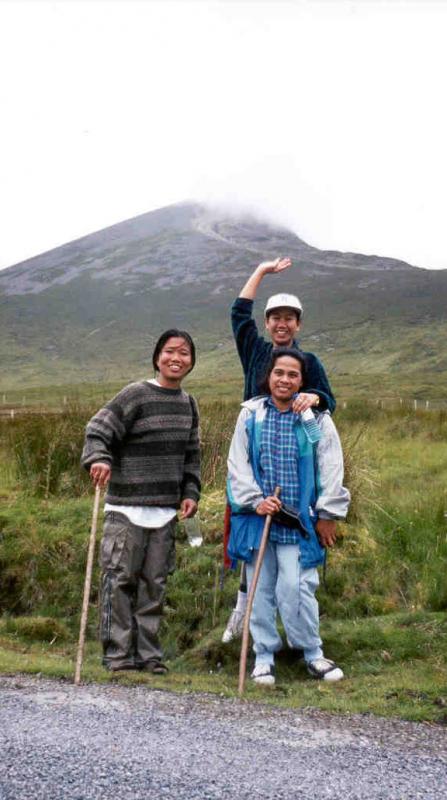
Climbing up the side of the mountain was exhausting. The stones were loose beneath our feet and it was very steep; every step I took had to be carefully done. Despite the exhaustion, what kept me moving was the encouragement of a fellow pilgrim, a hand from a stranger, a challenge from those people who were walking barefoot and my own determination to get there. I was able to face my own fears and recognized my strength. The stones I tread on became reminders of the people who have supported me through life. Each of them has made a great contribution to who I am today. I picked up a jagged stone to symbolize my human shortcomings and limitations and to be thrown away when I reached the summit. And I picked up a smooth-surfaced stone to remind me of the wanted change in myself which comes with God’s love and mercy.
Sacred Experience
At last we reached the summit. I had conquered the fear and had attained the desire of my heart. It was a wonderful feeling: awe and deep gratitude to God for this opportunity. The countless isles below, the cool breeze, the gentle clouds, everything was beautiful. An experience of sacredness clothed with peace and joy.
No wonder St. Patrick came here as do thousands of Christian followers around the world to experience this holiness, this awesome presence of God. So did I.